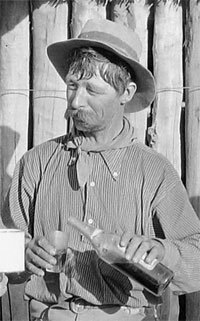




| » Images / Media | |||||
| » Web references | |||||
|
|||||
| » People | |||||
|
|||||
| » Notes | |||||
|
|
|||||
| » Where and when | |||||
|
|
|||||
| » Annotations | |||||
|
 Bob Buck was born in Alberton, South Australia on July 2 in either 1880 or 1881 (the year of birth varies). While little is known about his early life, he was the son of a labourer, also Robert Buck, and his wife Sarah Ann (nee Breaden), sister to Allan and Joe Breaden. Buck made his first trip to the Northern Territory in 1899. He worked at Walleroo for a few years before travelling north with his uncle Joe Breaden in 1905. Joe owned Todmorden Station and it is believed that Buck began learning the craft of the bushman during his time at Todmorden before leaving in 1907 to take up work at Henbury. The Breadens taught Buck how to manage station life, from stockwork to saddling and general management. Buck was based at Henbury for almost 21 years. Early on in his stewardship of that station he began a relationship with Molly, a local Aranda woman. Together the pair had a daughter called Ettie. While Bob Buck features prominently in ‘Journey to Horseshoe Bend’, he is most well known for his famous bushman skills and for his role in recovering Lasseter’s body. In 1931 Bob Buck was hired by the Central Australian Gold Exploration Company to lead their final expedition in search of Harold Lasseter’s body. The search was unsuccessful. A few weeks later Buck set out again with a smaller party and recovered the body on 28 March. He was awarded plaudits for his role in leading the team, cementing his reputation as a great Australian bushman (Cartwright, Strehlow). Bryan Bowman, however, who worked on a number of stations with Buck, contests the Buck mythology. Of Buck he writes that he was an 'indifferent bushmen, but he had an uncanny way of getting information from blacks and making them work. They both liked and respected him' (Bowman 20-21). According to Bowman, it was this 'uncanny' knack for obtaining information that helped him to find Lasseter. Bowman claims Buck found the body not because of his skill as a bushman, but because of his contact with a man called William and his wife Irrirwinze. William worked as a water drawer on the well at Middleton Ponds. Bowman claims William told Buck that Lasseter had been living with Aboriginal people in the Peterman Ranges, but had become very sick and had subsequently died. On hearing the story, Buck set out to find the body, accompanied by Johnson Breaden, and a group of Aboriginal trackers. They found the explorer’s remains in a cave on the Hull in three weeks. The story has since become legendary in Australia's bush lore (see Bob Buck's entry in the ADB online and Wiki entry listed below). Buck spent his remaining years in Alice Springs and died in 1960 aged 80. He is buried in the Alice Springs Cemetery on Memorial Avenue in the Catholic section of the cemetery. References: Bryan Bowman, "A History of Central Australia 1930-1980", pamphlet, 1989, pp 20-21 For a more detailed biography of Buck see Max Cartwright, "Central Australia: Of People and Places", Alice Springs: Self-published, 1994, pp 27-34 |
